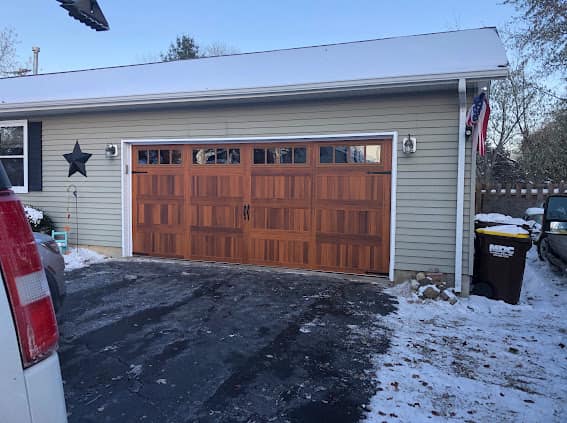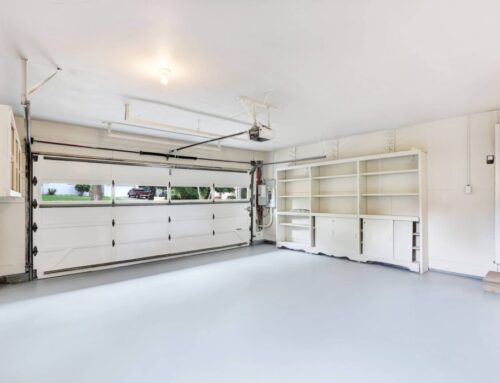Garage doors can be made from a variety of materials, each with its own advantages in terms of aesthetics, durability, and maintenance requirements. Some common materials used for garage doors include:
- Steel: Steel garage doors are popular due to their durability, security, and relatively low maintenance requirements. They can be insulated to improve energy efficiency and can be painted to mimic the look of wood.
- Wood: Wood garage doors provide a natural and classic look. They can be made from various types of wood, such as cedar, redwood, or mahogany. Wood doors require regular maintenance, including painting or staining, to protect them from the elements.
- Aluminum: Aluminum doors are lightweight, rust-resistant, and low-maintenance. They can be prone to dents, but they are often less expensive than steel or wood doors.
- Vinyl: Vinyl garage doors are durable, resistant to dents and rust, and require minimal maintenance. They are available in a variety of colors and styles. Vinyl doors are also good at resisting moisture, making them suitable for humid climates.
- Fiberglass: Fiberglass doors are lightweight, durable, and resistant to dents and corrosion. They can mimic the look of wood and are available in various finishes. Fiberglass doors are also good at resisting moisture and can be a good option for coastal areas.Here’s a step-by-step overview of how fiberglass garage doors are typically made:
- Fiberglass Sheets: The process starts with flat sheets of fiberglass material. Fiberglass is a strong and lightweight material that is often used for its durability and resistance to various environmental conditions.
- Reinforcement: To enhance the strength and rigidity of the fiberglass, the sheets are reinforced with materials such as steel, aluminum, or other composite materials. This reinforcement provides structural integrity to the door, ensuring it can withstand daily use and resist impacts.
- Molding: The reinforced fiberglass sheets are placed into molds that give the door its desired shape and design. These molds are often created with intricate patterns and textures to mimic the appearance of wood grain or other natural materials.
- Resin Application: A liquid resin, typically a polyester or epoxy resin, is applied to the fiberglass sheets within the molds. The resin acts as a bonding agent, ensuring that the reinforced fiberglass maintains its shape and structure once it hardens. The resin is evenly distributed to cover the entire surface of the door.
- Curing: The fiberglass and resin mixture is allowed to cure and harden within the molds. During this process, the resin solidifies, creating a strong and durable surface. Heat and pressure may be applied to expedite the curing process.
- Texturing and Finishing: After the fiberglass has fully cured, the surface is textured to create a realistic wood grain or other desired texture. This texturing process adds to the door’s aesthetic appeal. Additionally, a protective finish, often a gel coat, is applied to the surface. The gel coat provides UV protection and enhances the door’s resistance to fading, discoloration, and other environmental factors.
- Assembly: Once the individual panels are made, they are assembled into a complete garage door, including framing and any necessary hardware such as hinges, handles, and rollers.
- Composite: Composite garage doors are made from a combination of materials, often including wood fibers and resin. They offer the appearance of wood without the high maintenance requirements. Composite doors are durable, resistant to rot and insects, and can be painted or stained. The process of making composite garage doors involves several steps:
- Material Selection: High-quality wood fibers are combined with resin, often a type of high-density polyethylene (HDPE). The specific blend of materials may vary depending on the manufacturer, and sometimes recycled materials are used to make the composite, making it an environmentally friendly choice.
- Mixing: The wood fibers and resin are thoroughly mixed together to create a homogenous mixture. The ratio of wood fibers to resin can be adjusted to achieve the desired strength, durability, and appearance.
- Molding: The composite mixture is placed into molds that are shaped like the desired garage door panels. Hydraulic pressure and heat are applied to the molds to cure the composite material. This process ensures that the composite hardens and takes the shape of the mold.
- Texturing: After the composite material has cured and hardened, the surface is textured to resemble the appearance of natural wood. Manufacturers can create a variety of textures and finishes to mimic different wood types, such as oak, cedar, or mahogany.
- Coloring: Pigments or dyes can be added to the composite mixture during the manufacturing process to give the garage door its final color. Composite garage doors are available in a wide range of colors, and the color is often consistent throughout the material, reducing the visibility of scratches or dents.
- Finishing: Once the garage door panels are molded, textured, and colored, they may undergo additional finishing processes, such as applying a protective clear coat or UV-resistant finish. These finishes enhance the door’s durability and protect it from the effects of sunlight and weather.
The choice of material for a garage door often depends on factors such as budget, climate, desired aesthetics, and maintenance preferences. Each material has its own set of advantages and considerations, so homeowners should carefully weigh their options before making a decision.






